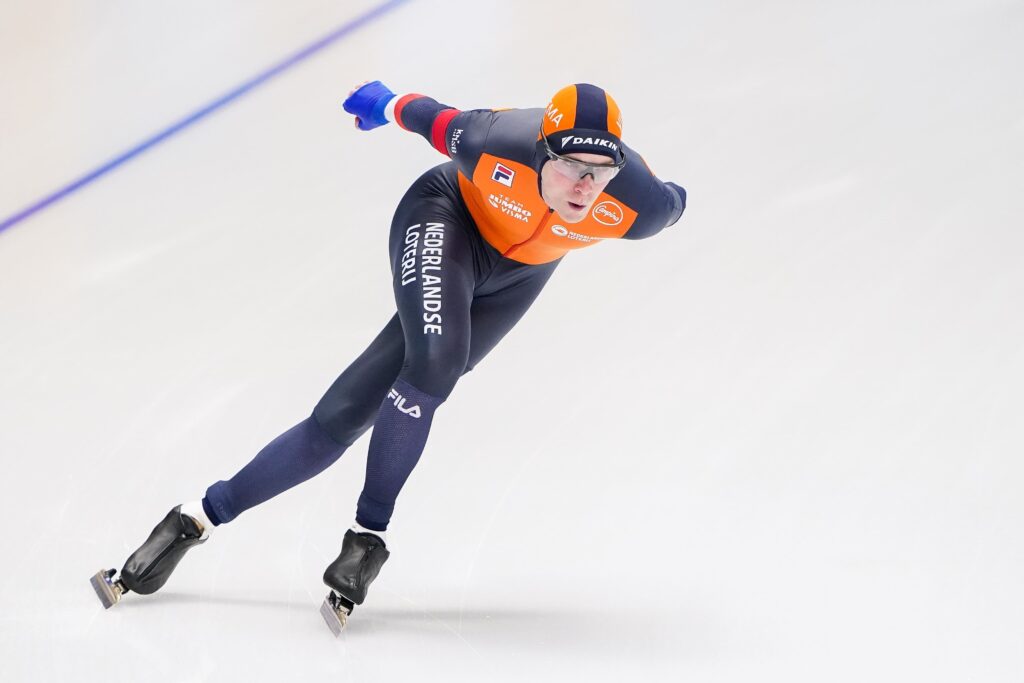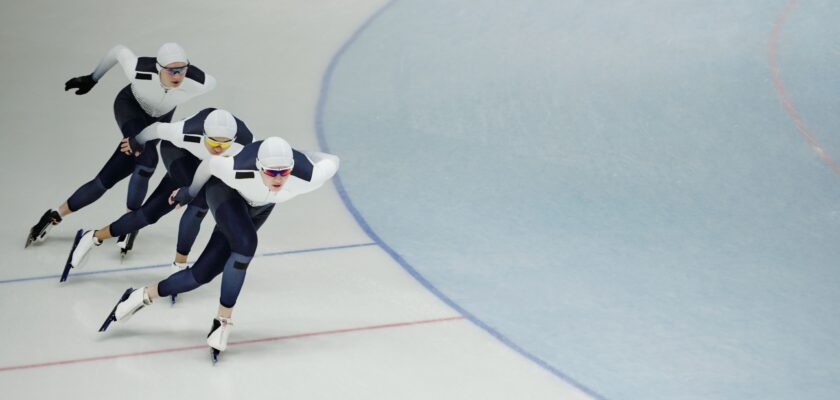Speed skating, or speed skating, is a sport performed on ice rinks, characterized by the speed and technique of the athletes. This sport is played on specific circuits where competitors glide across the ice in an attempt to reach the highest possible speeds. Do you want to know all about speed skating?
Open your Betano account and get up to 1,000 reais in bonuses.
Payments via PIX, live games and super odds!
Click here to open your account!

All about Speed Skating: history
The practice of speed skating is one of the oldest in the world. There are records dating back to antiquity of people making special shoes out of animal bones to cross frozen lakes and rivers in Holland, Scandinavia and other regions of northern Europe;
In the 13th century, the Dutch began to use the canals to move from village to village by skating;
Skating spread to England, where the first clubs and artificial rinks appeared;
Read to the end and learn all about speed skating!
Enthusiasts of the sport included members of the English monarchy, Napoleon III and the German writer Johann Wolfgang von Goethe.
It is believed that the first recorded skating competition took place in the Netherlands in 1676. The first official events in the sport took place in 1863 in Oslo, Norway;
The International Skating Union (ISU) was founded in 1891, and eight years later, the Netherlands hosted the first World Championships, bringing together local teams and Russian, American and British athletes, making it the oldest international competition.
Read to the end and learn all about speed skating!
Speed skating made its debut at the Winter Olympics in 1924 in Chamonix, France, initially for men only;
It wasn’t until the Lake Placid Games in 1932 that women were allowed to compete, albeit as a demonstration sport;
The official inclusion of women’s speed skating in the Olympic program took place at the 1960 Games in Squaw Valley, USA.
Read to the end and learn all about speed skating!
The races generally follow the European system, where skaters compete in pairs.
At the 1932 Olympic Games, the Americans introduced the mass start style, resulting in a boycott by many European competitors, which allowed the Americans to win four gold medals.
This system led to the development of short track speed skating, which was incorporated into the Olympic program in Albertville in 1992.
Read to the end and learn all about speed skating!
All about Speed Skating: equipment and categories
The main pieces of equipment used by a speed skater are threefold;
The most essential item is the skates, which have longer blades than those used in field hockey and figure skating, making it easier to increase speed;
On short tracks, the blades are fixed only at the front, which helps with cornering. Special goggles are used to protect athletes from the wind and ice fragments that may appear, and the use of a helmet is compulsory on short tracks.
In Speed Skating, the track is oval and measures 400 meters, similar to the size of an athletics track;
On short tracks, the oval circuit is 111 meters long and is usually shared with figure skating rinks.
Read to the end and learn all about speed skating!
Categories
- Allround: is speed skating’s most traditional competition, which brings together four events of different distances to identify the most versatile athlete in the sport.
- Mass Start: refers to the group start event in speed skating, which was included in the Olympic program in 2018.
- Sprint: term used to describe competitions that include only the 500 and 1000 meter races, the fastest distances in speed skating, which determine the fastest athlete in the sport.
Read to the end and learn all about speed skating!
All about Speed Skating: Brazil in sport
Brazil’s first steps in speed skating were taken in the short track discipline, with Felipe de Souza;
Between 2004 and 2007, he took part in several tournaments, including stages of the World Cup and the World Championships. In 2009, he became the first Brazilian to compete in a long track race.
After an administrative restructuring, the CBDG resumed its support for speed skating in 2015, forming a team with three young talents: João Victor da Silva, Marcelo Donadio and Gabriel Ohnmacht.
Brazil’s Speed Skating Achievements
- 2004 – Brazil makes its debut in speed skating with Felipe de Souza, who won the silver medal in the 500 meters at the South East Regionals in Canada.
- 2005– Felipe de Souza competed in the Short Track Skating World Cup, coming 87th in the 500 meters and 99th in the 1000 meters.
- 2006 – Felipe de Souza competed again in the World Cup of Short Track Skating, placing 49th in the 500 meters and 76th in the 1000 meters.
- 2007 – Brazil made its debut at the World Speed Skating Championships in the short track category, with Felipe de Souza finishing 42nd in the 500 meters, 47th in the 1000 meters and 53rd in the 1500 meters, ranking 51st overall.
- 2009– Felipe de Souza switched to the long track, marking Brazil’s first participation in traditional speed skating. He competed in the Canadian Cup in Calgary.
- 2015 – After a six-year break, Brazil returned to the sport with the participation of João Victor da Silva at the Allround Championships in Belarus.
- 2016 – Gabriel Ohnmacht and Marcelo Donadio joined the Brazilian speed skating team.
- 2017– The first edition of the Brazilian Speed Skating Sprint Championship was held in Inzell, Germany.
Read to the end and learn all about speed skating!
All about Speed Skating: differences to short track speed skating
If you’re wondering why in some races there are several skaters and in others only two, here’s the explanation.
In the speed skating, athletes compete against the clock, with no qualifiers, semi-finals or finals, just a single race where everyone tries to achieve the best possible time;
Two skaters compete at the same time, but what matters is not who crosses the finish line first, but the time recorded;
After completing the lap, the skater with the best time is declared champion.
In short-track speed skating, on the other hand, athletes compete against each other in several rounds. In this format, position is crucial, as the fastest advance to the next stages;
Normally, between four and six athletes compete in each race, going through qualifying rounds, quarter-finals, semi-finals and the final.
Read to the end and learn all about speed skating!
In short track speed skating, wearing a helmet is mandatory due to the higher risk of falls compared to speed skating;
Strategy is essential, especially here, as the athletes have to choose between leading to avoid conflicts with the peloton or staying behind to save energy.
However, there is one event in long-track speed skating where more than two athletes compete at the same time, and it is one of the most exciting, chaotic and challenging of the Olympic Games: the mass exit.
Introduced for men and women at PyeongChang 2018, the mass exit involves 12 athletes in each semi-final and 16 in the final.
The racers complete 16 laps, with the top three in each of the fourth, eighth and twelfth laps receiving points, in addition to the top three at the finish;
The first three to cross the finish line are considered champion, runner-up and third place respectively, but the score on the laps determines the classification of the other competitors.
Read to the end and learn all about speed skating!
The differences in Olympic competitions
Speed Skating
At the Beijing 2022 Olympic Games, speed skating will have 14 events, divided equally between men and women.
- For men: 500m, 1000m, 1500m, 5000m, 10,000m, mass start and team pursuit.
- For women: 500m, 1000m, 1500m, 3000m, 5000m, mass start and team pursuit.
A total of 112 places are available for athletes to qualify for the Olympic Games.
Short Track Speed Skating
The sport will have nine events at the Beijing 2022 Winter Games, with four events for men, four for women and one mixed event.
- For men: 500m, 1000m, 1500m, 5000m relay.
- For women: 500m, 1000m, 1500m, 3000m relay.
- Mixed: 2000m relay.
The top two from each heat advance to the next stage, culminating in the ‘A Final’, where the medals are contested.
Read to the end and learn all about speed skating!
Other distinctions
Track
Short track skating takes place on a smaller rink. The short track is 111.12 meters long, while the long track measures 400 meters, the same length as an Olympic athletics track.
Equipment
Due to the many sharp bends, short track athletes use rigid skates to maintain control of the trajectory;
Therefore, the material is significantly firmer compared to that used in speed skating;
The blades are also shorter, ranging from 30 to 45 cm on the short track, while on the long track they measure 40 to 55 cm.
Read to the end and learn all about speed skating!
As speed skating involves longer straights and wider turns, the skates are more flexible, known as ‘clap’, with a hinge in the heel, allowing the blade to remain in contact with the ice even when the leg is elevated.
Athletes’ physical profile
Due to the many curves on the short track, athletes with a lower center of gravity tend to have an advantage. In speed skating, on the other hand, it’s more common to find taller athletes.
Viktor Ahn, who won eight medals (including six gold) in the short track for the Republic of Korea and Russia, is 1.64m tall, while China’s Wang Meng is 1.67m;
In contrast, Sven Kramer, a four-time Olympic speed skating champion from the Netherlands, is 1.85m tall, and his compatriot Ireen Wüst, a five-time champion, is 1.68m tall.
Read to the end and learn all about speed skating!
All about Speed Skating: curiosities
- In speed skating, athletes compete against the clock, while in short track, the aim is to get to the finish line first.
- The short track speed skating rink shares the same structure as the figure skating rinks and is the same length as the athletics rinks (400m).
- The blades of the skates used in short track speed skating are smaller, ranging from 30 to 45 cm, while those used in long track measure 40 to 55 cm.
- The skates used on the long track are more flexible, known as ‘clap’ skates, with a hinge in the heel that allows the blade to remain in contact with the ice even when the leg is raised.
- There are also differences in the physical profile of the athletes: due to the many curves of the short track, athletes with a lower center of gravity have an advantage. In speed skating, it’s more common to see taller athletes. For example, Viktor Ahn, who has eight Olympic medals (six gold) in the short track, is 1.64m tall, while Sven Kramer, four-time Olympic speed skating champion from the Netherlands, is 1.85m tall.
- Lucas Koo, who will represent Brazil at Gangwon 2024 and achieved two top-10 results in the competition, was born in the United States and is of German and South Korean descent.
Now that you know all about speed skating, you should also learn more:



